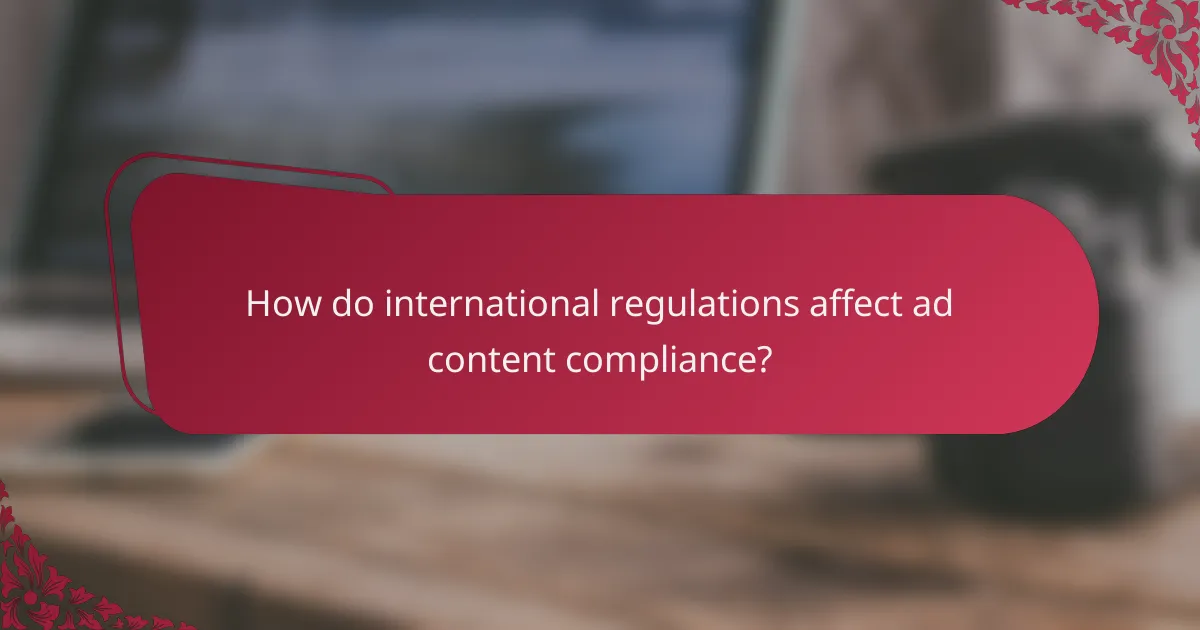Ad content compliance is crucial for maintaining legal and ethical standards in advertising. In the US, advertisements must be truthful, not misleading, and substantiated, adhering to regulations set by federal agencies. By implementing robust internal review processes and following industry standards, advertisers can mitigate risks and foster consumer trust.

What are the legal standards for ad content compliance in the US?
In the US, legal standards for ad content compliance require that advertisements be truthful, not misleading, and substantiated. Advertisers must adhere to various regulations set by federal agencies to ensure that their marketing practices are ethical and transparent.
Federal Trade Commission (FTC) guidelines
The Federal Trade Commission (FTC) provides clear guidelines for advertising practices to protect consumers from deceptive marketing. These guidelines require that ads must be truthful and backed by evidence, especially when making claims about a product’s performance or benefits.
Advertisers should ensure that any endorsements or testimonials used in ads are genuine and reflect the typical experiences of consumers. Failure to comply with FTC guidelines can result in significant penalties, including fines and mandated changes to advertising practices.
Truth in Advertising laws
Truth in Advertising laws mandate that all advertising must be honest and not misleading. This includes ensuring that all claims made in advertisements are accurate and can be substantiated with evidence. Misleading advertisements can lead to legal repercussions and damage to brand reputation.
Advertisers should regularly review their content to ensure compliance with these laws, especially when launching new campaigns. A common pitfall is exaggerating product benefits, which can easily lead to violations.
Children’s Online Privacy Protection Act (COPPA)
The Children’s Online Privacy Protection Act (COPPA) imposes specific requirements on advertisers targeting children under 13 years old. This law mandates that websites and online services collect parental consent before gathering personal information from children.
Advertisers must be cautious when creating content aimed at children, ensuring that it complies with COPPA regulations. Non-compliance can result in hefty fines and legal actions, making it crucial for marketers to understand their obligations when advertising to younger audiences.

How can advertisers ensure ethical guidelines are followed?
Advertisers can ensure ethical guidelines are followed by adhering to established industry standards and implementing robust internal review processes. These practices help maintain integrity and trust with consumers while minimizing legal risks.
Adherence to industry codes of conduct
Adhering to industry codes of conduct is essential for ethical advertising. These codes, often set by organizations like the American Advertising Federation or the Advertising Standards Authority in the UK, provide a framework for acceptable practices and help prevent misleading claims.
Advertisers should regularly review and familiarize themselves with these codes to ensure compliance. For example, avoiding exaggerated claims about product efficacy or ensuring that advertisements are not offensive or discriminatory are key aspects of these guidelines.
Implementation of internal review processes
Implementing internal review processes is crucial for maintaining ethical standards in advertising. This involves establishing a team responsible for reviewing all advertising content before it is published, ensuring it aligns with both legal requirements and ethical guidelines.
Effective internal reviews can include checklists that cover aspects such as truthfulness, clarity, and respect for consumer rights. Regular training for staff on ethical advertising practices can further enhance compliance and reduce the risk of errors that could lead to reputational damage or legal issues.

What are the risks of non-compliance in display advertising?
Non-compliance in display advertising can lead to significant legal, reputational, and trust-related risks. Advertisers must be aware of these potential pitfalls to safeguard their business and maintain a positive relationship with consumers.
Legal penalties and fines
Failure to comply with advertising regulations can result in substantial legal penalties and fines. Depending on the jurisdiction, these fines can range from hundreds to millions of dollars, particularly for serious violations such as false advertising or misleading claims.
Regulatory bodies, like the Federal Trade Commission (FTC) in the United States, actively monitor advertising practices and can impose sanctions. Companies should regularly review their advertising content to ensure it meets all legal requirements to avoid these costly repercussions.
Damage to brand reputation
Non-compliance can severely damage a brand’s reputation, leading to negative publicity and loss of market position. Once a brand is associated with unethical advertising practices, it can take years to rebuild consumer perception.
For instance, a company found guilty of misleading advertisements may face backlash on social media, which can amplify the damage. Brands should prioritize transparency and ethical guidelines in their advertising strategies to protect their reputation.
Loss of consumer trust
When consumers perceive a brand as non-compliant or dishonest, they are likely to lose trust, which can lead to decreased sales and customer loyalty. Trust is a critical component of consumer relationships, and once it is broken, regaining it can be challenging.
To maintain consumer trust, advertisers should ensure that their claims are truthful and substantiated. Engaging in ethical advertising practices not only fosters trust but also encourages long-term customer relationships and brand loyalty.

What frameworks exist for managing ad content compliance?
Several frameworks help organizations manage ad content compliance, focusing on legal standards, ethical guidelines, and risk management. These frameworks ensure that advertising practices align with regulatory requirements and maintain consumer trust.
Compliance checklists
Compliance checklists serve as practical tools to ensure that all advertising content adheres to relevant laws and ethical standards. These lists typically include key areas such as truthfulness, non-deceptive claims, and proper disclosures.
When creating a compliance checklist, consider including items like verifying claims with supporting evidence, ensuring appropriate disclaimers are present, and confirming that content does not infringe on intellectual property rights. Regularly updating the checklist to reflect changes in regulations is crucial.
Regular training programs for marketing teams
Implementing regular training programs for marketing teams is essential for maintaining ad content compliance. These programs should cover legal standards, ethical advertising practices, and the latest industry trends to keep teams informed and prepared.
Training sessions can include workshops, online courses, and guest speakers from legal or regulatory backgrounds. Encourage team members to stay engaged by incorporating real-world case studies and compliance scenarios that they may encounter in their roles.

What tools can help with ad content compliance?
Several tools can assist in ensuring ad content compliance, including compliance management software and automated content review platforms. These tools help businesses adhere to legal standards and ethical guidelines while minimizing risks associated with non-compliance.
Compliance management software
Compliance management software streamlines the process of monitoring and managing compliance with advertising regulations. These platforms often include features for tracking changes in laws, storing documentation, and managing audits.
When selecting compliance management software, consider factors such as user-friendliness, integration capabilities with existing systems, and the ability to customize alerts for specific regulations. Popular options include tools like ComplyAdvantage and LogicManager.
Automated content review platforms
Automated content review platforms analyze ad content for compliance with legal and ethical standards before publication. These tools use algorithms to detect potential issues, such as misleading claims or inappropriate language, and provide suggestions for revisions.
When using automated content review platforms, ensure they are updated regularly to reflect the latest regulations and industry standards. Examples include platforms like AdVerif.ai and Ziflow, which can significantly reduce the time spent on manual reviews.

How do international regulations affect ad content compliance?
International regulations significantly shape ad content compliance by establishing legal frameworks that advertisers must follow. These regulations vary by region and can impose strict requirements on data protection, truthfulness, and ethical standards in advertising.
General Data Protection Regulation (GDPR)
The General Data Protection Regulation (GDPR) is a comprehensive data protection law in the European Union that affects how advertisers handle personal data. Under GDPR, businesses must obtain explicit consent from individuals before collecting or processing their personal information for advertising purposes.
Advertisers should ensure transparency by clearly informing users about how their data will be used. Non-compliance can lead to substantial fines, often reaching up to 4% of a company’s annual global turnover or €20 million, whichever is higher. Regular audits and data protection impact assessments can help maintain compliance.
Advertising Standards Authority (ASA) guidelines in the UK
The Advertising Standards Authority (ASA) in the UK sets guidelines to ensure that advertisements are legal, decent, honest, and truthful. Advertisers must adhere to these standards to avoid misleading consumers and to promote responsible advertising practices.
Key considerations include avoiding exaggerated claims and ensuring that advertisements do not exploit vulnerable groups. Advertisers should regularly review ASA rulings and case studies to understand compliance expectations and adjust their content accordingly. Familiarizing oneself with the CAP Code, which outlines the rules for non-broadcast advertising, is essential for compliance in the UK market.

What are emerging trends in ad content compliance?
Emerging trends in ad content compliance highlight the increasing importance of adhering to legal standards and ethical guidelines. Advertisers must navigate evolving regulations and consumer expectations to mitigate risks and maintain trust.
Increased focus on data privacy
Data privacy has become a critical concern for advertisers as regulations like GDPR in Europe and CCPA in California impose strict requirements. Companies must ensure that they collect, store, and use consumer data responsibly, often requiring explicit consent before engaging in targeted advertising.
To comply, businesses should implement robust data management practices, including regular audits and transparency in data usage. Failure to adhere to these privacy standards can lead to significant fines and reputational damage.
Use of AI for compliance monitoring
Artificial intelligence is increasingly being utilized to monitor ad content for compliance with legal and ethical standards. AI tools can analyze large volumes of advertisements quickly, identifying potential violations or misleading claims before they reach the public.
By employing AI, companies can streamline their compliance processes, reduce human error, and respond swiftly to any issues. However, it is essential to ensure that AI systems are regularly updated to reflect current regulations and ethical guidelines.
Growing consumer demand for transparency
Consumers are increasingly demanding transparency from brands regarding their advertising practices. This trend is pushing companies to disclose information about how ads are targeted and the data used in the process.
To meet this demand, brands should consider adopting clear communication strategies that explain their advertising practices. Providing consumers with insights into data usage and ad targeting can enhance trust and foster long-term loyalty.


